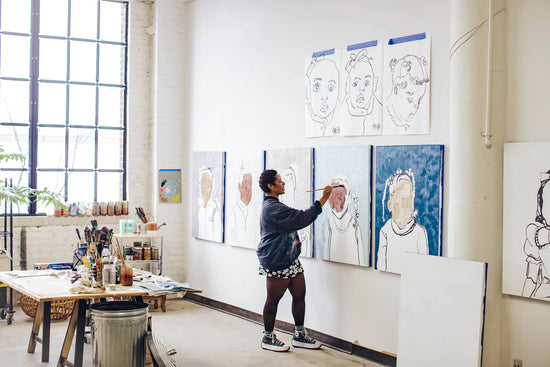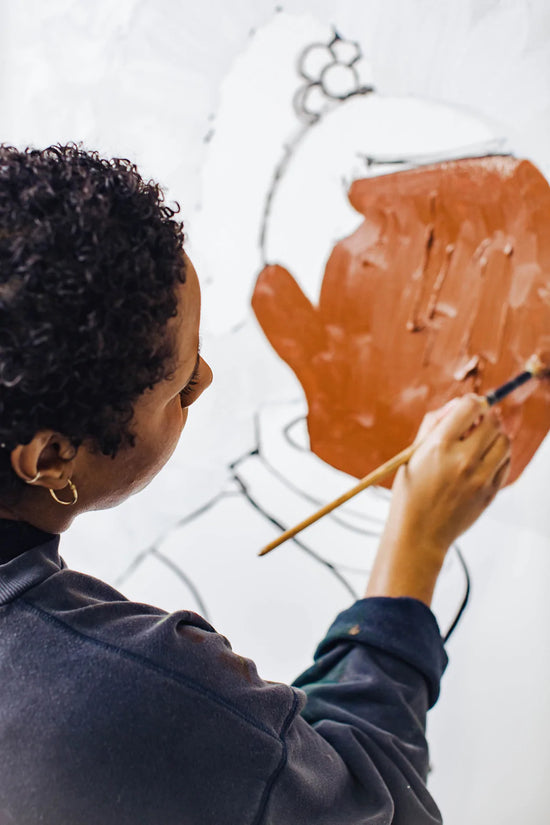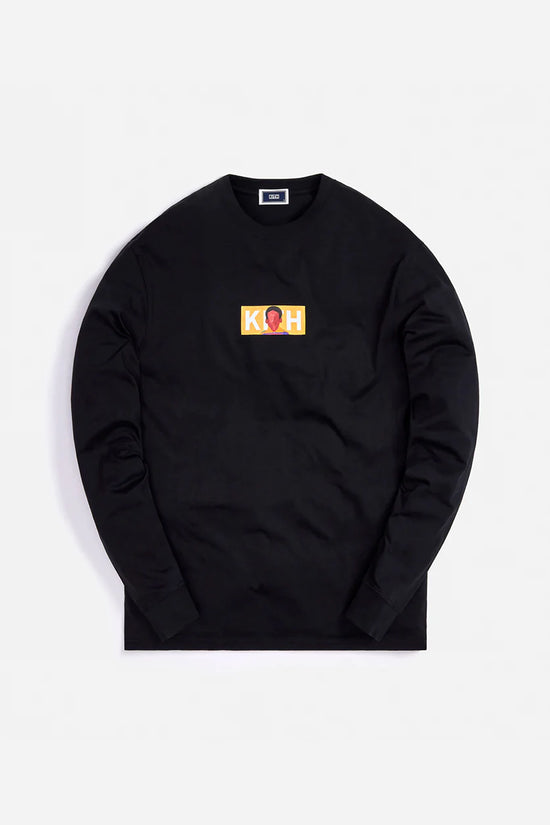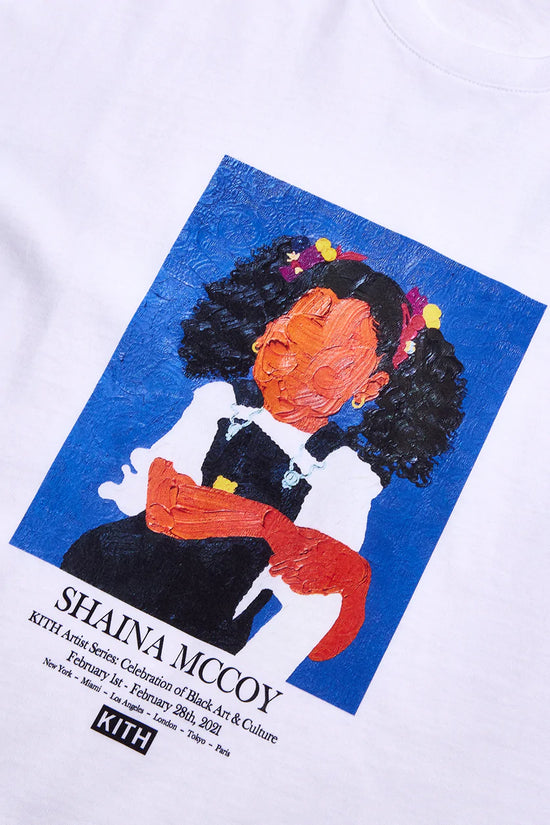To celebrate Black History Month, we have worked with three Black artists to create a capsule that will release on February 8. Each artist has reimagined our classic logo in their signature style
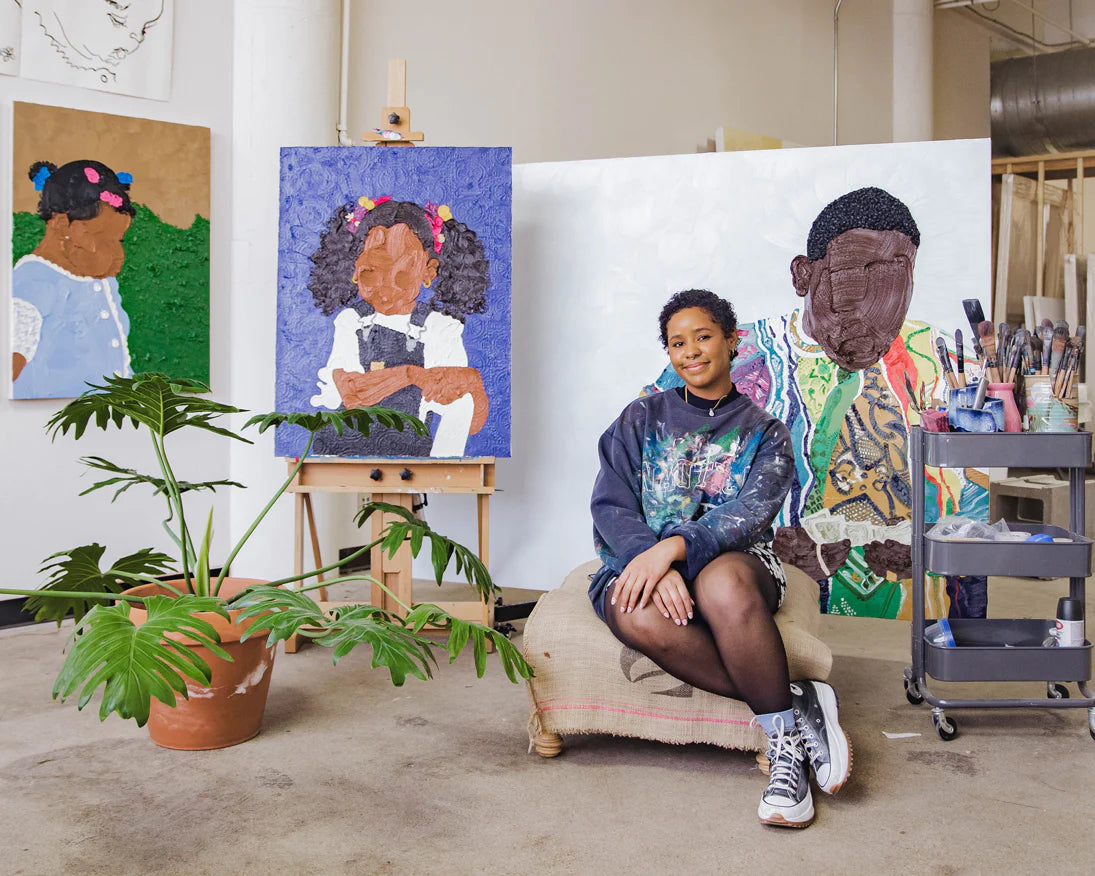
Shaina McCoy began painting while studying at the Perpich Center for Arts Education (Golden Valley, MN) in 2012. She attended Normandale Community College from 2013-2014, and graduated with an Associate of Arts from Minneapolis Community and Technical College in 2018. Her work has been included in group exhibitions at Ever Gold Projects in San Francisco, Gildar Gallery in Denver, as well as
Art4Shelter, PLOT and City Wide Artists Gallery in Minneapolis. McCoy lives and works in Minneapolis, Minnesota. A forthcoming solo exhibition of her work, A Family Affair, will open at Ever Gold Projects in September 2019.
Greg Betty, Kith's Senior Graphic Designer who worked with the artists to create the apparel capsule, sat down with Shaina McCoy to have a conversation about her process, the impact of family on her work, and embracing heritage in the Black community, and more.
Photography by Tayo Kuku
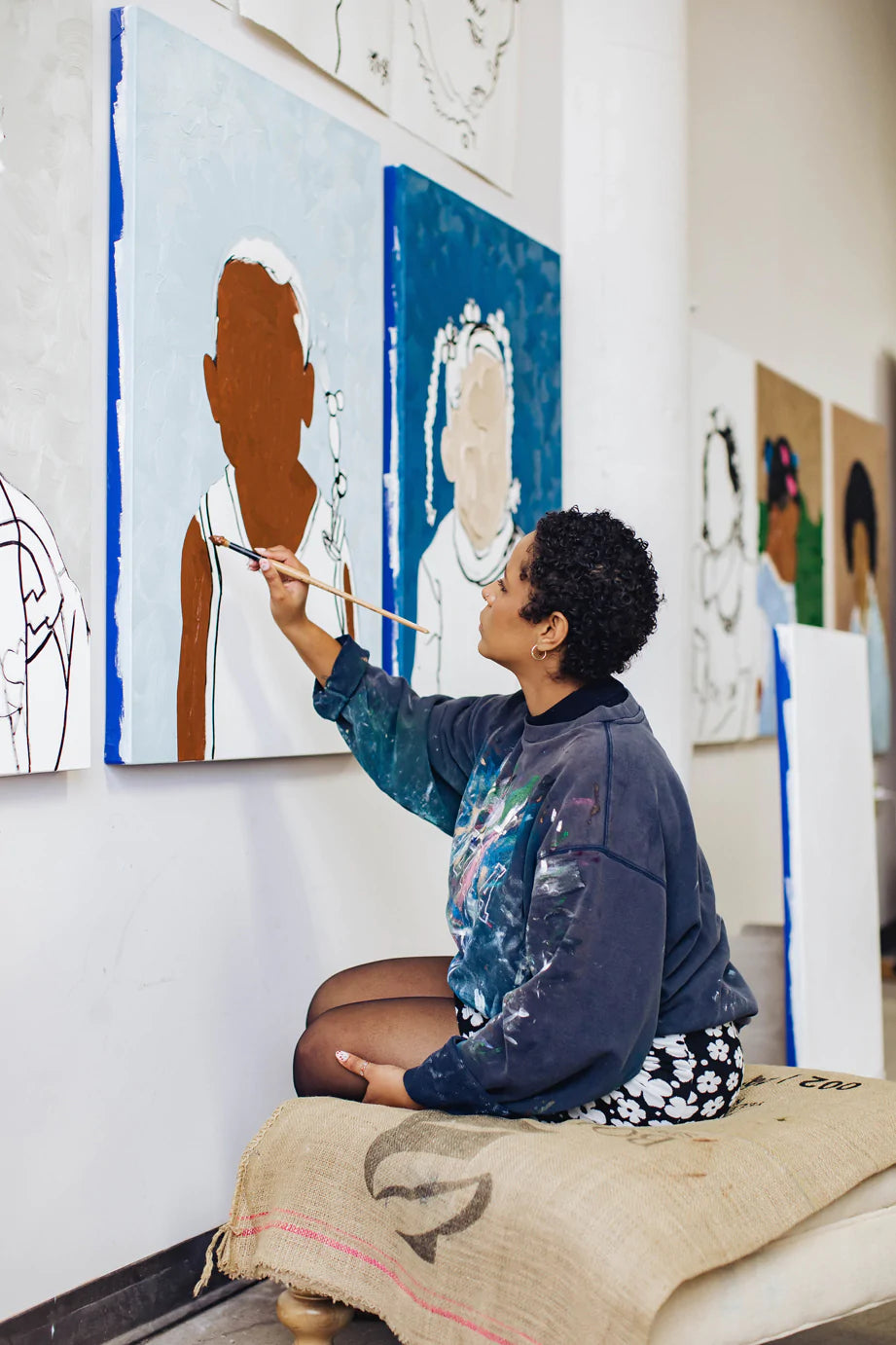
GB: It’s a pleasure to finally meet you even though we've been working together digitally for awhile. Before we get into your work, can you just tell us a little bit about yourself?
SM: My name is Shaina McCoy. I'm a Minneapolis painter. I grew up here and have been here all my life. I went to an Arts High School called Perpich Center in Minnesota and that's where I really fell in love with the medium and learned my style, which came as an organic process of not knowing how to utilize the medium. I could draw with charcoal and graphite but I couldn't paint realistically like my peers who were portraying their family members at the time, doing landscape or animals and still life. I really wanted to paint but I couldn’t, but I had a lot of encouragement from my studio art teachers to keep on working because my style was uniquely mine. Megan, my studio art teacher at the time used to say, “I haven't seen anyone do it like this before. It's uniquely you, it's beautiful, simple, and angelic. Keep doing that thing.” I had a lot of encouragement and it gave me confidence in that moment to continue the same work or style that I didn't really think was artwork.
GB: A lot of times you don't really see teachers encouraging the students that way. It's almost like you need to conform to everybody else or you have to get out of the class. She embraced your individuality and saw that there was more in you.
GB: Can you tell us where the name Wallflower comes from?
SM: It comes from The Perks of Being a Wallflower. I just thought of myself as quiet and behind the scenes, watching everyone do their thing. It was mad simple, this is me. I am a personable human being when it comes to being face-to-face with people and sharing space.
GB: Do you remember what you wanted to be before you became a full-time artist?
SM: I grew up wanting to be an art teacher. I also wanted to be a fashion designer. So when I was younger, it was more art teacher because I always had my hands on anything creative. I was always given creative gifts as a younger kid. I was making keychains. Anything I could get my hands on, from drawing to painting. It was always encouraged and supported by my family members so I grew up wanting to be an art teacher because I thought that would be a fun thing, they seemed pretty relaxed and I wanted to use education to inspire students to be free within themselves because they are always looked at differently, especially being a Black youth, it’s like you have to play basketball or be a dancer or sing. For other folks, you either can be a lawyer or a doctor. To me, it's like, “What about the artists?” Artists make the world go around. Everything that you are wearing, sitting on, living in, is all made by an artist. I think that we really have an important part to play. My aunt went to Harvard and she wanted me to go to Pratt since I also wanted to be a fashion designer at a young age. After I visited New York and toured FIT and Parsons, I thought, “Wow this environment and community is so different.” Slowly I found myself growing and not fitting into that.
GB: You still kept creativity in your DNA, so I'm really glad you pursued your passion. Speaking of your work, you've done countless shows in Minneapolis since 2015 and you had a show in Denver. Can you tell us a little bit about those experiences?
SM: I had a friend in Denver, Justin, and he was a part of this exhibition and he had connected me with that team. They invited me out to be a part of this curated exhibition and I was super excited about it because I wasn't part of any exhibition groups prior to that. It was called Now More Than Always. I was in that show with other folks, and I had two Big Poppa pieces and they were really tiny and on wood panels. I went out there and stayed in this little Airbnb with the slide-in door and I was only there for two days so I made it work. I'm not big on camping but I didn’t need the top notch 4-star hotel. It was cute but I definitely couldn't do it for any longer. So I had the group exhibition and met a bunch of cool artists there who had sculpture work, paintings, video installations. I was thinking wow, you can really mobilize yourself when you're connected on the internet in this way and I mobilized art. That just puts things into perspective - I can still live here and make my art and it can get pushed out all over the world. I don't have to move to LA or New York because this is my foundation here in Minneapolis. I really love my family. Even being in LA for 3 months was a little bit too much for me.
GB: I want to talk about your solo show, A Family Affair.
SM: It took place in San Francisco at Ever Gold with Andrew McClintock, the gallerist there. I had created the pieces in Pasadena. It was a lot of stress. Right now I'm currently working on a show that's for next month and I told myself, I would never do that again. I don't want that pressure creating right before a show, I want to be locked and loaded and ready with inventory. Should anything come about, I can put some pieces together and just send them off. I've been working on that now but A Family Affair was so beautiful. My dad and stepmom came out to support, and my mom surprised me and I just started crying. My grandma brought food out and she was like, “Wow this is what my baby girl is doing,” and my dad started crying.
GB: It's crazy how Black families move as a unit. It's empowering, but at the same time, it makes you feel like a kid again. You could be thirty-years-old and as soon as your family comes around, you just feel like a five-year-old again. Just going back a little, you were talking about the power of being able to be in Minneapolis and get your work all over the world and being able to network. 2020 was definitely the year creatives were able to share their work instantly since we were in lockdown. How important is the internet to you and do you use it consistently to get your work out there?
SM: I think the internet is a free marketing tool right now that people should be using if they are passionate about something. Share your work, you never know who's watching. That's the reason why I get to do what I do, being a full-time artist is because of the internet. Putting out those things even if I didn't think they were perfect, somebody saw them and liked it and that's usually the case. If you don't like it, somebody else will and you shouldnt be scared about that. There is a lot of mobility within the Black community to share work that really touched our souls, because it came out of pain, suffering, and trauma. Our natural reaction is to respond in love and in resilience. However, I really internalized that trauma, everything happened here in Minnesota and trickled across the states but I definitely think the internet is a tool to use, if you want to share information with anybody. Things are spreading like wildfire, so if you can see how one thing can spread, you never know who's watching when it comes to your art. Somebody is going to love it and there's art for everyone. You may not like it but art is successful if it makes you feel anything. It can be good, it can be bad, but if art makes you feel a certain way then it has served its purpose.

GB: Similar to Jackson Pollock and Monet, texture is definitely one of the biggest focuses in your work. The thickness of the paint strokes and the smears represent the emotion that you fill your work with and although your style is impressionistic and abstract, there still is an undeniable, visible feeling in each one of your works. When did you find your particular painting style? Did somebody help you develop that?
SM: I developed it, it was an organic thing that happened back in 2012 in high school. It came from not knowing how to use the medium and at Perpich, there was this guest studio art teacher, Megan Rye. She is a Korean-American painter and she wanted to do ten paintings each week for the next three weeks. We painted them and they were 5x7 portrait-size paintings. From there, we all developed our style and she mentioned that these paintings serve a specific purpose - they were going to an Art for Shelter, which is an annual benefit for the house of community here in the Twin Cities. Each piece would be sold for $30 and that would help a person have a night at the shelter and provide them all their basic necessities. Since 2012, I've been participating in Art for Shelter. I remember asking how many paintings do I have to do to donate $1,000 to Simpson Housing Services because I really wanted to push that. I did those paintings and they sold out the first year. I was in shock because the events were all white people who really appreciate this kind of art, there was a market and I tapped into it. I didn't know how to paint realistically like I mentioned, so finding that art style was a very unique experience. My dad grew up in the lower-middle-class and he took me to Michael's Arts and Crafts Store and he couldn't afford the fancy brushes and I of course didn't have any means of income, being in high school. He was like, “Here are your choices, you get one brush.” We got the assortment pack, which was around $11.99. I felt like a spoiled brat, wanting to have the highest quality materials being in art school. Other students had access to that and I didn't. So, my dad got me the assortment pack and I used those brushes in class the next day and I still remember them because they became one of my dearest tools. They gave me my first glimpse of texture and of what would become my style now. Years after high school, I came in contact with this collector in LA and he asked if I can do bigger canvases. I was trying to be optimistic and challenge myself because that's all I dreamed of - being in arts schools and having access to larger canvases. Go big or go home, right? He wanted me to produce two pieces, one on a 3x4 ft canvas and one on a 5x4 ft canvas. I had never made anything that large at that time so I created them and he loved it and I still work with him until this day. I think it's so important to use the materials and resources you have at hand. You might not have access to the ones that you want and that's okay, but push for that and continue to work on things with the materials that you do have because you never know how it's going to unfold. It might go your way, it might not, but never lose hope.
GB: Besides texture, there's a heavy focus on nostalgia in your work. When I look at your portraits, I feel like I'm on my grandma's couch, scrolling through a ridiculously large binder full of childhood Polaroids and Kodak pictures. Even though your subjects are faceless and anonymous, there's enough familiarity and seemingly Black-only cues that allow me to envision myself in my youth being in these scenarios. Those beautiful innocent moments in pictures always make you wish you didn't grow up so fast. Why is childhood nostalgia so important to you?
SM: I am reminded by this quote which states, “Be the person that you needed to be when you were younger,” and I didn't have any Black artists to look up to growing up, especially when those things aren’t shared heavily. All we know is Basquiat and there wasn't a Black woman fine artist that I could look up to growing up. I wanted to be that person so much, so relying on childhood nostalgia is so important to me, to recall what family means because we still get to love each other and still get to see me grow. I get back in my feels and touch base with my emotions, they’re my route and a reminder to celebrate the people that brought me up. I look back on these childhood portraits and see who's holding me or pushing me on the swing or who I’m watching TV with. It’s so sweet to have those photographs and documents, because it makes me look forward to my future family.
GB: I want to talk to you about the importance of family, especially the Black-American household. What does family mean to you?
SM: Family is my foundation. It's what I know and I also challenge myself to break generational cycles in which I see how my parents were raised, how they decided to raise me, and in my everyday actions. It's nurturement and continues to feed the fire I have inside. I think a lot of people get out in the world with their careers and forget where they come from. I think it is so important because I wouldn't be who I am today without my father and my grandma who raised my father to be the man that he needed to be. My grandmother stepping up and being an incredible woman led my dad to teach me a lot of things. He was very militant then but now I understand him and I give thanks. I pay homage constantly to him, my grandma, and my mom. It's important to remember your roots and never forget that because so many people want to separate that identity or don’t even know where they come from, unfortunately. In different instances, we all have different family dynamics but I want to let the world know that the real McCoy family, we are solid. If you ever meet a McCoy, know that you're in good company. We humble ourselves in that and are also very prideful. We want to continue to change the narrative because McCoy is a white Irish name. I don't know what my descendants look like, all I know is who I can be today carrying that last name and my family is really proud of that.
GB: I love that and it perfectly segues into my next question. Although I'm a Black-American, my entire family migrated to America from Jamaica. My grandma is Jamaican and German, I’m the first male born here and I’m still figuring it out as I go. I'm sure there are a lot of similarities and differences between our households, such as tradition, music, food and mannerisms. Do you feel like even though our upbringings are different, our struggles are still the same?
SM: We are all a part of the diaspora at the end of the day. I think it is so important to recognize the differences and unity as being one because a lot of people have a tendency to celebrate and be prideful. There is nothing wrong with being prideful of where your people come from but we are one and we have to bring that full circle because people are going to look at us as the same folks in this country. I think our struggles are the same and also very different.
GB: How is this feeling of depicting “Black unity” shown in your work?
SM: I want to say Black unity because I also share Afro-Latino heritage and we have folks all across the range of melanin. I think it's so important to depict that through my work because that's who I am and that's where my people come from. Although I did not know my great-grandmother from Mexico, I do see images of her. I see my grandma and her siblings and my grandpa in all these images. I think it is so important to show how dynamic the range and complexity of Black folks is. We're not just one type, there is so much culture to that and we should accept that and welcome it with open arms. It is such a good feeling to walk in your full Blackness and recognize your lineage, and understand this identity is so strong across the nation.
GB: When I was putting your version of the logo together, I definitely wanted to make sure there was emphasis on the face and the texture that you use. I even filled the K I T H with your texture just to show people that this is what you do. Now that I know that it's your dad on the classic logo, it makes it even better. How does he feel knowing that he's going to be on the logo?
SM: He feels really good. Sometimes I have to be careful though because I’m not trying to blow his head up too big now. He's proud and I am so humble and happy to be able to have my family be a part of this just as much as the art is.
GB: You said you wanted to be a teacher and I think you're teaching me a lot right now just through this conversation. I want to talk about our collaborative project; we asked each artist to reinterpret the Kith classic logo in their own stylistic way. Can you explain to us who Troy Lee is and what does this person being intertwined in the Kith classic logo mean to you?
SM: Honestly, that's my dad, I painted my father as a young boy. He had this striped sweatshirt in this little Polaroid. I painted it and then produced a print of it and it was so beautiful to see because the portrait had a yellow background and you see my dad's little afro and it's got the hair texture that I use and his face also resembles a sunflower. I thought it was perfect to use for Kith for the colors and his name starts with a T so he's right on the T on the classic logo.
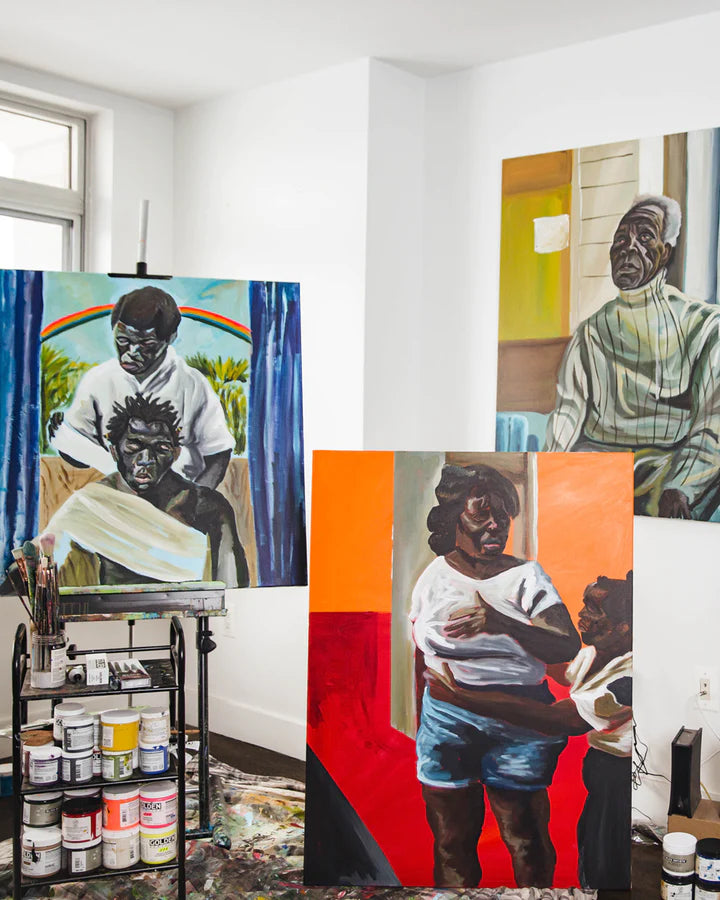
GB: You keep that theme of family very true to your work. What does the second piece you worked on mean to you?
SM: That is a self portrait that I completed; me as a young girl with big ponytails, Poo Bear clips and overalls, and I love the background color in that. We all have those portraits outside of school portraits. I think it's Black history in the making. My dad being on the other shirt, I get to show something that is active in the present-day, Black history in the making and it goes back to the person that you needed to be when you were younger. I had an image and this is me when I was younger. Here I am being the person that I needed and I want to continue to be a role model for all the Black and Brown kids across the states. To inspire them to be whoever they want to be and they can see themselves in that portrait.
GB: I think your younger self would be very proud of the woman she would become in the future. What can the world expect next from Shaina McCoy in the future?
SM: I have lots of projects I am working on right now. There will be a show at Stems Gallery in Belgium in late March. I'm working on a project of little Black girls with baubles, beads, and barrettes. Then after that I have a show in Ghana, it's going to be so sick. I had obtained portrait photographs, Kodachrome slides from my grandpa who's a photographer, who's taken over 80% of the photographs that I use for my imagery and paintings. He came upon this box from this woman who took a trip to Africa back in the 1960s, where she toured the country and collected photos. To see those images, I was inspired to do something outside of my standard family portraiture. Go back to folks from Africa and give them the acknowledgement that they deserve instead of being inside of a shoe box tucked away somewhere. My grandpa gave me these and I knew exactly what I wanted to do, which is to paint these images. I may not get to all five hundred but I'm going to paint the ones that strike and move me, the ones that really are calling to be seen, heard and felt. I'm going to be painting for the show come next year. That's what there is on the radar right now. I am also working on an album cover for someone special.
GB: Wow, that's amazing. Thank you Shaina.
SW: Thank you.

